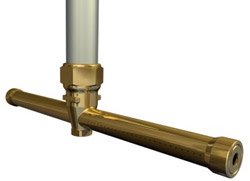Silent Nozzle Extinguisher Does Not Harm Hard Disks

The system is especially suitable for use in computer centers that store sensitive data. That’s because loud noise can cause hard disk drives to fail. However, the noise created by the Sinorix Silent Nozzle remains below the level that would endanger hard disk drives.
As is the case in many industrial facilities and archives, fires at computer centers are generally not extinguished with water but with gas. If a fire breaks out, the extinguishing systems flood the room with natural gases such as argon, nitrogen, or carbon dioxide within seconds, displacing oxygen in the process. Alternatively, chemical extinguishing agents can be used. These extinguish fires by extracting heat (energy) from the flames. The discharge of gas by conventional nozzle systems is very loud and can reach noise levels of 130 decibels or more, which is equivalent to a fighter jet taking off. In rare cases, computer center operators have noticed that such extinguishing systems have caused hard disk drives to fail temporarily. Studies have confirmed that this failure was the result of the hard disks’ sensitivity to noise.
The new nozzle from Siemens Building Technologies is designed to keep the noise level below 100 decibels, as this comparatively low noise level doesn’t damage hard disks. The nozzle also makes it possible for the operator to choose the direction in which the gas will be discharged so that the sound waves will have a minimal impact on the hard disks.
The nozzle can use the natural gases nitrogen or argon, and a similar nozzle concept is currently being developed for chemical extinguishing agents. The flooding times are identical to those for conventional nozzles. The new nozzle is fully compatible with the Sinorix gas extinguishing system and can also be retrofitted into existing facilities.
Media Contact
More Information:
http://www.siemens.com/innovationnewsAll latest news from the category: Power and Electrical Engineering
This topic covers issues related to energy generation, conversion, transportation and consumption and how the industry is addressing the challenge of energy efficiency in general.
innovations-report provides in-depth and informative reports and articles on subjects ranging from wind energy, fuel cell technology, solar energy, geothermal energy, petroleum, gas, nuclear engineering, alternative energy and energy efficiency to fusion, hydrogen and superconductor technologies.
Newest articles

A universal framework for spatial biology
SpatialData is a freely accessible tool to unify and integrate data from different omics technologies accounting for spatial information, which can provide holistic insights into health and disease. Biological processes…

How complex biological processes arise
A $20 million grant from the U.S. National Science Foundation (NSF) will support the establishment and operation of the National Synthesis Center for Emergence in the Molecular and Cellular Sciences (NCEMS) at…

Airborne single-photon lidar system achieves high-resolution 3D imaging
Compact, low-power system opens doors for photon-efficient drone and satellite-based environmental monitoring and mapping. Researchers have developed a compact and lightweight single-photon airborne lidar system that can acquire high-resolution 3D…





















